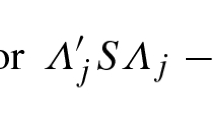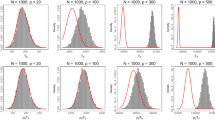Abstract
It is assumed that the investigator has set up a simple structure hypothesis in the sense that he has specified the zero loadings of the factor matrix. The maximum-likelihood method is used to estimate the factor matrix and the factor correlation matrix directly without the use of rotation methods, and the likelihood-ratio technique is used to test the simple structure hypothesis. Numerical examples are presented.
Similar content being viewed by others
References
Anderson, T. W.An introduction to multivariate statistical analysis. New York: Wiley, 1958.
Anderson, T. W. and Rubin, H. Statistical inference in factor analysis. In J. Neyman (Ed.),Proceedings of the third Berkeley symposium on mathematical statistics and probability. Vol. V. Berkeley: Univ. Calif. Press, 1956, 111–150.
Box, G. E. P. A general distribution theory for a class of likelihood criteria.Biometrika, 1949,36, 317–346.
Davidon, W. C. Variable metric method for minimization. A.E.C. Research and Development Report, ANL 5990, Argonne National Laboratory, 1959.
Finkel, R. W. The method of resultant descents for the minimization of an arbitrary function. Paper 71, Preprints of Papers Presented at 14th National Meeting of Association of Computing Machinery, 1959.
Howe, W. G. Some contributions to factor analysis. Report No. ORNL-1919. Oak Ridge National Laboratory, Oak Ridge, Tenn., 1955.
Jöreskog, K. G.Statistical estimation in factor analysis. Stockholm: Almqvist & Wiksell, 1963.
Jöreskog, K. G. Computer program for estimating and testing a simple structure hypothesis in factor analysis. Res. Memo. 65-3. Princeton, N.J.: Educ. Test. Serv., 1965.
Jöreskog, K. G. On rotation to a specified simple structure. Res. Bul. 65-13. Princeton, N. J.: Educ. Test. Serv., 1965.
Lawley, D. N. Estimation in factor analysis under various initial assumptions.Brit. J. statist. Psychol., 1958,11, 1–12.
Lawley, D. N. and Maxwell, A. E.Factor analysis as a statistical method. London: Butterworths, 1963.
Reiersøl, O. On the identifiability of parameters in Thurstone's multiple factor analysis.Psychometrika, 1950,15, 121–149.
Spang, H. A. III. A review of minimization techniques for nonlinear functions.SIAM Rev., 1962,4, 343–365.
Thurstone, L. L.Multiple-factor analysis. Chicago: Univ. Chicago Press, 1947.
Wilks, S. S. The large-sample distribution of the likelihood ratio for testing composite hypotheses.Ann. math. Statist., 1938,9, 60–62.
Author information
Authors and Affiliations
Additional information
The work was supported by a grant (NSF-GB 1985) from the National Science Foundation to Educational Testing Service. Reproduction in whole or in part for any purpose of the United States Government is permitted.
The work was carried out when the author was Visiting Research Statistician at Educational Testing Service. The author wishes to thank Dr. Frederic M. Lord for many helpful suggestions throughout the course of this study.
Rights and permissions
About this article
Cite this article
Jöreskog, K.G. Testing a simple structure hypothesis in factor analysis. Psychometrika 31, 165–178 (1966). https://doi.org/10.1007/BF02289505
Received:
Revised:
Issue Date:
DOI: https://doi.org/10.1007/BF02289505




